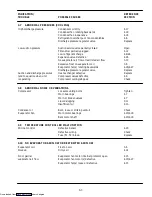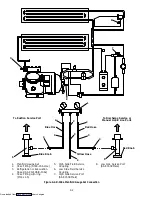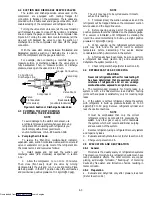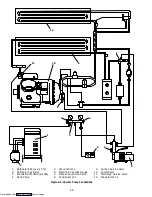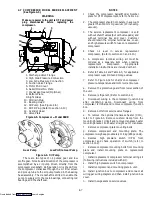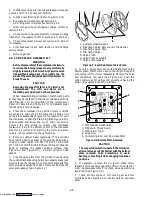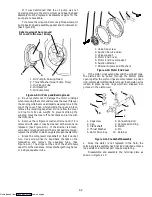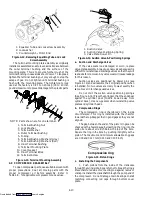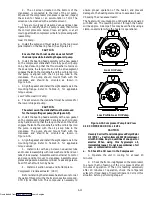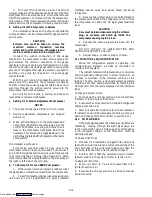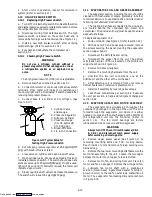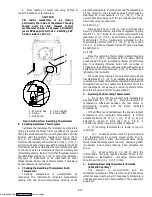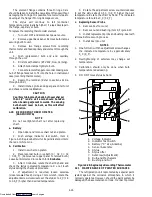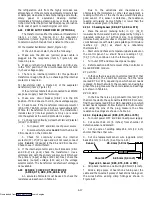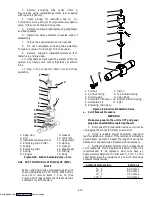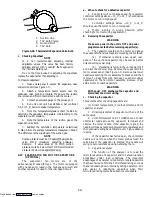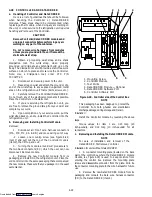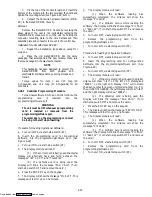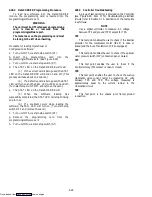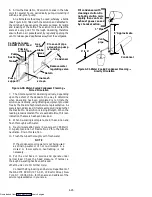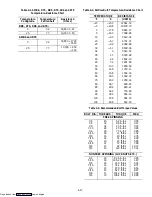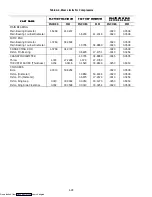
4-13
c. After unit is in operation, inspect for moisture in
system. (Refer to section 4.11.)
4.13 HIGH PRESSURE SWITCH
4.13.1 Replacing High Pressure Switch
a. Turn OFF unit start-stop switch. Frontseat both suction
and discharge service valves to isolate compressor. Remove
the refrigerant from the compressor.
b. Disconnect wiring from defective switch. The high
pressure switch is located on the center head and is
removed by turning counterclockwise. (See Figure 1-1.)
c. Install a new high pressure switch after verifying
switch settings. (Refer to section 4.13.2.)
d. Evacuate and dehydrate the compressor per
section 4.5.1.
4.13.2 Checking High Pressure Switch
WARNING
Do not use a nitrogen cylinder without a
pressure regulator. Do not use oxygen in or near
a refrigeration system as an explosion may
occur.
NOTE
The high pressure switch (HPS) is non-adjustable.
a. Remove switch as outlined in section 4.13.1.
b. Connect ohmmeter or continuity light across switch
terminals. Ohm meter will indicate no resistance or
continuity light will be illuminated if switch closed after
relieving compressor pressure.
c. Connect hose to a cylinder of dry nitrogen. (See
Figure 4-17.)
1. Cylinder Valve
and Gauge
2. Pressure Regulator
3. Nitrogen Cylinder
4. Pressure Gauge
(0 to 36 kg/cm
@
=
0 to 400 psig)
5. Bleed-Off Valve
6. 1/4 inch Connection
1
2
3
4
5
6
Figure 4-17. Typical Setup for
Testing High Pressure Switch
d. Set nitrogen pressure regulator at 26.4 kg/cm
@
(375
psig) with bleed-off valve closed.
e. Close valve on cylinder and open bleed-off valve.
f. Open cylinder valve. Slowly close bleed-off valve to
increase pressure on switch. The switch should open at a
static pressure up to 25 kg/cm
@
(350 psig). If light is used,
light will go out and if ohmmeter is used, the meter will
indicate open circuits.
g. Slowly open bleed-off valve to decrease the pressure.
The switch will close at 18 kg/cm
@
(250 psig).
4.14 EVAPORATOR COIL AND HEATER ASSEMBLY
The evaporator section, including the coil, should be
cleaned with fresh water or steam, preferably. Another
recommendation is to use Oakite 202 or similar cleaner
following
manufacturer’s instructions.
The two drain pan hoses connected to the drain pan,
are routed behind the condenser fan motor and
compressor. The drain pan line(s) must be open to ensure
adequate drainage.
To Replace Evaporator Coil:
a. Pump unit down. (See Figure 1-3, refer to section 4.3.)
b. With power OFF and power plug removed, remove
the screws securing the panel covering the evaporator
section (upper panel).
c. Disconnect the defrost heater wiring.
d. Disconnect the sensor from the coil. The defrost
termination sensor (DTS) is located on the middle coil
support as shown in Figure 1-2.
e. Remove middle coil support.
f. Remove the mounting hardware from the coil.
g. Unsolder the two coil connections, one at the
distributor and the other at the coil header.
h. After defective coil is removed from unit, remove
defrost heaters and install on replacement coil.
i.
Install coil assembly by reversing above steps.
j.
Leak check connections per section 4.4. Evacuate
the unit per section 4.5 and add refrigerant charge per
section 4.6.2.
4.15 EVAPORATOR FAN AND MOTOR ASSEMBLY
The evaporator fans circulate air throughout the
container by pulling air in the top of the unit. The air is
forced through the evaporator coil where it is either
heated or cooled and then discharged out the bottom of
the refrigeration unit into the container. (Refer to
section 1.4.)
The fan motor bearings are factory
lubricated and do not require additional grease.
WARNING
Always turn OFF the unit circuit breakers (CB-1
& CB-2) and disconnect main power supply
before working on moving parts.
a. Remove upper access panel (See Figure 1-1) by
removing mounting bolts and T.I.R. locking device.
Reach inside of unit and remove Ty-Rap securing wire
harness loop.
b. Remove the two lower mounting bolts that secure the
motor-fan assembly to the unit. Loosen the two upper
bolts as the motor mount upper holes are slotted.
c. Remove motor, fan, and wiring from unit. Place fan
motor and fan on a support. Remove the wiring and fan.
d. Lubricate fan motor shaft with a graphite-oil
solution (Never-Seez). Apply thread sealer (Loctite H,
brown in color) to the two fan set screws. Install fan on
motor. The evaporator fan locating dimension is shown
in Figure 4-18.
Downloaded from

